|
Updated | Federal weather forecasters released their winter outlook Thursday, and it doesn’t look good for drought-stricken northern California, Oregon and Washington state. A strong El Niño this winter is predicted to intensify the Western drought through at least January, the National Oceanic and Atmospheric Administration announced. Earlier this week, NASA released a new image of… Continue reading El Niño Won’t Relieve West’s Drought, NOAA Predicts |
Category Archives: Climatology
Thornton’s October preview: Fall should finally make an appearance
 With the first full month of fall here, October usually brings one of the quietest weather months in the Denver area with plenty of mild, sunny days and clear, cool nights.
With the first full month of fall here, October usually brings one of the quietest weather months in the Denver area with plenty of mild, sunny days and clear, cool nights.
October is historically the second sunniest month and conditions are generally calm.
However we also will usually see our first taste of winter during the month with the first freeze and first snowfall of the season. Temperatures as well will start to drop and by the end of the month the average nighttime lows are below freezing.
For complete details on our historical October weather and what we can expect in the coming month, read our complete October weather preview here.
September 2015 weather recap: One of the warmest, driest on record
With the mercury stuck stubbornly at the top of the scale and barely a few raindrops falling into the bucket, September 2015 will be going into the books as one of the warmest and driest on record.
High pressure dominated the entire region during the month. This allowed temperatures to consistently climb above normal and helped prevent moisture from arriving in any significant amounts. At Denver International Airport, 27 of the 30 days had above normal temperatures. Thornton’s overall temperatures were cooler than DIA’s but we were still quite a bit warmer than average.
The monthly average temperature in Thornton came in at 67.1 degrees. Out at the airport where the Mile High City’s official measurements are taken, the average was 69.4 degrees.
Denver’s historical average for September is 63.4 so both locations came in well above normal. Officially, September 2015 ranks as the warmest September on record, easily jumping to the number one spot over September 1948 which had an average of 68.3 degrees.
Undoubtedly the big difference between measurements at DIA and other locations in the metro area are yet another example of the airport’s readings consistently being an outlier from the reality seen in more populated areas. This has been an ongoing problem since the National Weather Service moved the official station from Stapleton.
The warmest mercury reading in Thornton during the month was 94 degrees on the 13th. The coldest came on the 19th when temperatures dipped to 40 degrees in the early morning hours. Eight days in Thornton topped out above the 90 degree mark.
At the airport, Denver’s warmest reading of 92 degrees came on September 2. It’s coldest on September 19 (44 degrees). The airport saw seven days with above 90 degree maximums.
Just as the month was exceedingly warm, it also was very dry. Thornton saw a mere 0.09 inches fall in its rain bucket and Denver recorded 0.11 inches. Both were far short of the September precipitation average of 0.96 inches.
DIA’s measurement means September 2015 goes into the books with the 9th least amount of precipitation in September since 1872 (16th driest overall).
Click here to view Thornton’s September 2015 climate report.


From the National Weather Service:
CLIMATE REPORT
NATIONAL WEATHER SERVICE BOULDER, CO
244 AM MDT THU OCT 1 2015
...THE DENVER CO CLIMATE SUMMARY FOR THE MONTH OF SEPTEMBER 2015...
CLIMATE NORMAL PERIOD 1981 TO 2010
CLIMATE RECORD PERIOD 1872 TO 2015
WEATHER OBSERVED NORMAL DEPART LAST YEAR`S
VALUE DATE(S) VALUE FROM VALUE DATE(S)
NORMAL
................................................................
TEMPERATURE (F)
RECORD
HIGH 97 09/06/2013
09/05/2013
09/04/1995
LOW 17 09/29/1985
HIGHEST 92 09/02 91 1 94 09/03
LOWEST 44 09/19 35 9 33 09/12
AVG. MAXIMUM 85.2 78.5 6.7 78.9
AVG. MINIMUM 53.5 48.3 5.2 50.6
MEAN 69.4 63.4 6.0 64.8
DAYS MAX >= 90 7 3.4 3.6 2
DAYS MAX <= 32 0 0.0 0.0 0
DAYS MIN <= 32 0 0.8 -0.8 0
DAYS MIN <= 0 0 0.0 0.0 0
PRECIPITATION (INCHES)
RECORD
MAXIMUM 5.61 2013
MINIMUM T 1892 1944
TOTALS 0.11 0.96 -0.85 1.79
DAILY AVG. 0.00 0.03 -0.03 0.06
DAYS >= .01 3 6.5 -3.5 9
DAYS >= .10 0 3.3 -3.3 4
DAYS >= .50 0 0.6 -0.6 1
DAYS >= 1.00 0 0.1 -0.1 1
GREATEST
24 HR. TOTAL 0.12 08/31 TO 09/01 09/29 TO 09/29
09/28 TO 09/29
09/29 TO 09/29
STORM TOTAL MM MM
(MM/DD(HH)) MM 09/29(00) TO 09/29(00)
09/29(00) TO 09/29(00)9
09/29(00) TO 09/29(00)9
SNOWFALL (INCHES)
RECORDS
TOTAL MM MM
TOTALS 0.0 1.3
DEGREE_DAYS
HEATING TOTAL 9 125 -116 91
SINCE 7/1 27 141 -114 98
COOLING TOTAL 148 76 72 88
SINCE 1/1 861 764 97 701
FREEZE DATES
RECORD
EARLIEST 09/08/1962
LATEST 06/08/2007
EARLIEST 10/07
LATEST 05/05
..........................................................
WIND (MPH)
AVERAGE WIND SPEED 9.0
RESULTANT WIND SPEED/DIRECTION 2/195
HIGHEST WIND SPEED/DIRECTION 35/280 DATE 09/07
HIGHEST GUST SPEED/DIRECTION 54/270 DATE 09/07
SKY COVER
POSSIBLE SUNSHINE (PERCENT) MM
AVERAGE SKY COVER 0.40
NUMBER OF DAYS FAIR 12
NUMBER OF DAYS PC 17
NUMBER OF DAYS CLOUDY 1
AVERAGE RH (PERCENT) 41
WEATHER CONDITIONS. NUMBER OF DAYS WITH
THUNDERSTORM 6 MIXED PRECIP 0
HEAVY RAIN 0 RAIN 3
LIGHT RAIN 7 FREEZING RAIN 0
LT FREEZING RAIN 0 HAIL 3
HEAVY SNOW 0 SNOW 0
LIGHT SNOW 0 SLEET 0
FOG 3 FOG W/VIS <= 1/4 MILE 5
HAZE 1
- INDICATES NEGATIVE NUMBERS.
R INDICATES RECORD WAS SET OR TIED.
MM INDICATES DATA IS MISSING.
T INDICATES TRACE AMOUNT.
Fall Foliage 2015: Top spots to view the colors near the Front Range
This time of year many folks head to the hills west of Denver in search of gold – fall foliage gold.
This year the changing of the colors seems to be a bit spotty and an early freeze last fall followed by a late freeze this spring has impacted the overall quality of the show. That certainly is not to say there isn’t some absolutely gorgeous spots out there.
Where to go? Below are five of ThorntonWeather.com’s favorite ones near Denver – plus a few further out and some bonus ideas. After that, we will tell you where you can find a great website that provides regular updates on viewing conditions.
I-70 Corridor – If you’re looking for the easiest route, then this one is for you. Simply head west on I-70 about 110 miles to Avon. Between Vail and Avon, both sides of I-70 are lined beautifully with aspen.
Rocky Mountain National Park – One of the most popular summer destinations in the state is of course also a prime spot to view aspen in all their glory. Once in the park head toward Bear Lake. Glacier Gorge Junction provides a beautiful spot and you of course also get to enjoy all the splendor that Rocky Mountain National Park has to offer. Extend your viewing by taking Trail Ridge Road all the way through to the west side of the park and the Grand Lake and Granby area.
Peak to Peak Highway – This little road trip can be a dual purpose trip – gambling and fall foliage viewing! Take U.S. 6 through Clear Creek Canyon and then 119 through Blackhawk and Central City. You can of course stop there if your wallet is fat enough and donate some money to the casinos. From there continue on 119 toward Nederland. Take highway 72 toward Ward and Allenspark. There you will find more golden aspen than you can imagine, all with the Continental Divide nearby.
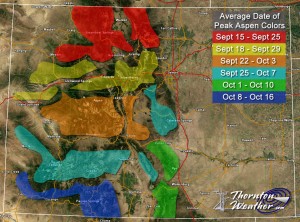
Poudre Valley Canyon – Heading north on I-25 take Colorado 14 west and into Poudre Canyon and Roosevelt National Forest. As you continue west you will come very near timberline as you come to Cameron Pass. Amazing views abound!
Guanella Pass – This is a nice, relatively short drive from Denver. From C470 take 85 through Bailey and Conifer, a nice drive unto itself. When you come to the town of Grant, take the Guanella Pass Scenic and Historic Byway north to Georgetown. The air is pretty thin along the way as you climb in excess of 11,500 views through the Pike and Arapahoe National Forests. Fair warning – about 10 miles of the road is gravel but it is well maintained.
A couple other possibilities further from the Front Range:
Leadville / Aspen – From Denver take I-70 west to Copper Mountain and then Colorado 91 south over Freemont Pass to Leadville. Along the way there are plenty of viewing opportunities and Leadville is a nice little town to make a stop. From here you can take Highway 24 north back through Minturn and Vail. To extend the drive, take Highway 24 south to Colorado 82 and head toward Aspen. You can stop by the Maroon Bells in White River National Forest to view some of the most photographed mountains in Colorado.
Cottonwood Pass – From Denver take Highway 285 to Buena Vista. Head west on Main Street for seven miles then west on County Road 344 / Colorado 82. From there you start the climb up Cottonwood Pass with absolutely stunning views from the top. If you are up for it, you can continue down the west side of the pass into the Taylor Park area. Be forewarned though that the western half of the pass is unpaved and twisty.
Honorable mentions worth considering:
- Boreas Pass between Breckenridge and Como (County Road 10)
- Kenosha Pass on Highway 285 between Bailey and Fairplay
- Independence Pass (Colorado 82 between Aspen and Twin Lakes)
- Colorado 103 from Evergreen to Echo Lake. Throw in a drive up Mount Evans for a bonus.
If you do head out, be sure to send us your pictures for inclusion in our monthly photo slideshows!
- Email: info@ThorntonWeather.com
- Facebook: https://www.facebook.com/ThorntonWeather
- Google+: https://plus.google.com/+Thorntonweather
- Twitter: @ThorntonWeather (https://twitter.com/thorntonweather)
For more information:
August 2015 weather recap: Month saw near normal temps, below average precipitation
High pressure was the dominant feature across much of Colorado during the month of August 2015. This helped keep temperatures quite warm and while there were occasional storms, they failed to deliver much in the way of precipitation.
We started out the month very warm and dry. This was interrupted on the 9th when a series of disturbances finally brought some measurable precipitation. Dry weather returned for a few days but then a strong cold front moved bring much cooler temperatures from the 17th to the 19th. The break was short-lived and warmer mercury readings and drier conditions dominated the balance of the month.
Thornton’s average temperature for the month came in at 71.8 degrees, not far off Denver’s long term average for August of 72.5 degrees. Out at DIA where the Mile High City’s official readings are taken, it was much warmer with an average of 74.0 degrees.
Temperatures in Thornton ranged from a high of 98.1 degrees on the 15th down to a low of 45.3 degrees on the morning of the 19th. Denver’s maximum reading of 98 degrees came on the 15th as well and its lowest reading of 43 degrees came on the 23rd.
We saw 18 days with high temperature readings above the 90 degree mark. Denver saw one more than that.
Two daily high temperature records were tied in Denver during the month, those coming on the 18th and 26th with readings of 98 and 97 degrees respectively. Additionally, two mornings in a row fell to record lows. The record low temperature for the 18th (47 degrees) was tied and the following day a new record low of 47 degrees was set.
In terms of precipitation, a paltry 0.87 inches fell in Thornton’s rain bucket. Out at the airport, Denver recorded 1.18 inches. Both were well below Denver’s long term average of 1.69 inches for August.
Click here to view Thornton’s August 2015 climate report.


From the National Weather Service:
CLIMATE REPORT
NATIONAL WEATHER SERVICE BOULDER, CO
244 AM MDT TUE SEP 1 2015
...................................
...THE DENVER CO CLIMATE SUMMARY FOR THE MONTH OF AUGUST 2015...
CLIMATE NORMAL PERIOD 1981 TO 2010
CLIMATE RECORD PERIOD 1872 TO 2015
WEATHER OBSERVED NORMAL DEPART LAST YEAR`S
VALUE DATE(S) VALUE FROM VALUE DATE(S)
NORMAL
................................................................
TEMPERATURE (F)
RECORD
HIGH 105 08/08/1878
LOW 40 08/26/1910
08/25/1910
08/24/1910
HIGHEST 98 08/15 105 -7 91 08/19
08/17
LOWEST 43 08/23 40 3 52 08/31
08/30
08/25
AVG. MAXIMUM 89.8 87.2 2.6 83.8
AVG. MINIMUM 58.3 57.9 0.4 57.4
MEAN 74.0 72.5 1.5 70.6
DAYS MAX >= 90 19 11.5 7.5 4
DAYS MAX <= 32 0 0.0 0.0 0
DAYS MIN <= 32 0 0.0 0.0 0
DAYS MIN <= 0 0 0.0 0.0 0
PRECIPITATION (INCHES)
RECORD
MAXIMUM 5.85 1979
MINIMUM 0.02 1924
TOTALS 1.18 1.69 -0.51 2.73
DAILY AVG. 0.04 0.05 -0.01 0.09
DAYS >= .01 9 8.6 0.4 13
DAYS >= .10 4 4.3 -0.3 5
DAYS >= .50 1 1.2 -0.2 3
DAYS >= 1.00 0 0.3 -0.3 0
GREATEST
24 HR. TOTAL 0.68 08/11 TO 08/11 08/25 TO 08/26
08/10 TO 08/11 08/31 TO 08/31
08/11 TO 08/11 08/31 TO 08/31
STORM TOTAL MM MM
(MM/DD(HH)) MM 08/26(00) TO 08/26(00)
08/31(00) TO 08/31(00)1
08/31(00) TO 08/31(00)1
SNOWFALL (INCHES)
RECORDS
TOTAL MM MM
TOTALS 0.0 0.0
DEGREE_DAYS
HEATING TOTAL 13 10 3 2
SINCE 7/1 18 16 2 7
COOLING TOTAL 304 244 60 182
SINCE 1/1 713 688 25 613
FREEZE DATES
RECORD
EARLIEST 09/08/1962
LATEST 06/08/2007
EARLIEST 10/07
LATEST 05/05
..................................................
WIND (MPH)
AVERAGE WIND SPEED 9.6
RESULTANT WIND SPEED/DIRECTION 3/189
HIGHEST WIND SPEED/DIRECTION 38/260 DATE 08/31
HIGHEST GUST SPEED/DIRECTION 47/340 DATE 08/09
SKY COVER
POSSIBLE SUNSHINE (PERCENT) MM
AVERAGE SKY COVER 0.50
NUMBER OF DAYS FAIR 6
NUMBER OF DAYS PC 23
NUMBER OF DAYS CLOUDY 2
AVERAGE RH (PERCENT) 45
WEATHER CONDITIONS. NUMBER OF DAYS WITH
THUNDERSTORM 15 MIXED PRECIP 0
HEAVY RAIN 1 RAIN 4
LIGHT RAIN 12 FREEZING RAIN 0
LT FREEZING RAIN 0 HAIL 5
HEAVY SNOW 0 SNOW 0
LIGHT SNOW 0 SLEET 0
FOG 4 FOG W/VIS <= 1/4 MILE 0
HAZE 8
- INDICATES NEGATIVE NUMBERS.
R INDICATES RECORD WAS SET OR TIED.
MM INDICATES DATA IS MISSING.
T INDICATES TRACE AMOUNT.
Denver sets second consecutive record low temperature
 For the second day in a row, the Mile High City has set or tied a record low temperature. The events certainly bring to mind the quickly approaching fall.
For the second day in a row, the Mile High City has set or tied a record low temperature. The events certainly bring to mind the quickly approaching fall.
This morning, as measured at Denver International Airport, Denver’s temperature officially dropped to a low temperature of 47 degrees. This bests the previous record low temperature for August 19 of 48 degrees last set in 2002.
Here in Thornton we actually were a bit cooler as we dipped to 45 degrees, our coldest reading since May 30. This was also the coldest temperature on August 19 we have recorded in Thornton since ThorntonWeather.com came online in 2006.
Today’s record-setting temperature follows on yesterday’s record-tying low temperature of 47 degrees. Additionally, highlighting the extremes we experience here in Colorado, it was just the previous Saturday that we tied the record high for the date (98 degrees).
Denver ties record low temperature for August 18
 From record heat to record cold. As measured at Denver International Airport, the temperature in the Mile High City dropped to 47 degrees at 5:17am. This tied the record low temperature for the date last set in 1960.
From record heat to record cold. As measured at Denver International Airport, the temperature in the Mile High City dropped to 47 degrees at 5:17am. This tied the record low temperature for the date last set in 1960.
It was just a few days ago that Denver tied a record high temperature on August 15. Ironically, that record was previously hit in 1960 as well.
Here in Thornton we managed to stay a bit warmer with a low of 49.7 degrees. This was our coldest temperature reading since May 31 (49.4 degrees).
July 2015 weather recap: Cooler than normal temps, a bit drier than average
The month of July continued the recent trend of cool, damp weather. By the time it was said and done though, while temperatures overall were below average, precipitation fell short of normal.
Temperatures were at or above normal for the first few days allowing for a pleasant Independence Day.
The day after, however, a monsoonal weather pattern cooled things down and brought most of the month’s moisture over the following 10 days.
Ridging then built and we settled into a relatively normal period for the final two weeks although precipitation became scarcer.
Thornton saw an average temperature for July 2015 of 71.2 degrees. This was a good bit below the long term Denver average of 74.2 degrees. Out at Denver International Airport where the Mile High City’s official measurements are taken, the average for the month was 72.8 degrees.
Our temperatures ranged from a high of 96.1 degrees on the 27th down to a low of 53 degrees on the 11th. Denver saw a maximum of 97 degrees and a minimum of 52 degrees.
Denver averages 2.16 inches of precipitation during July. Thornton fell a bit short of that mark recording 1.76 inches. At the airport, only 1.06 inches was recorded.
Click here to view Thornton’s July 2015 climate report.
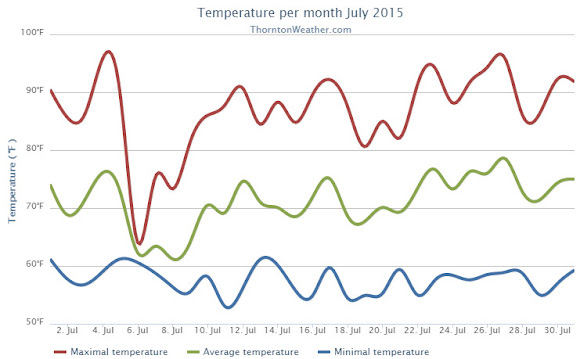
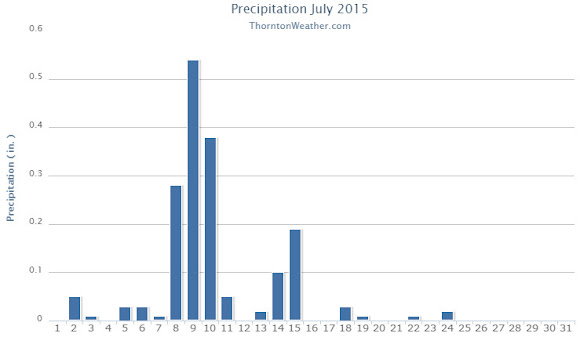
CLIMATE REPORT
NATIONAL WEATHER SERVICE BOULDER, CO
202 PM MDT SAT AUG 1 2015
...................................
...THE DENVER CO CLIMATE SUMMARY FOR THE MONTH OF JULY 2015...
CLIMATE NORMAL PERIOD 1981 TO 2010
CLIMATE RECORD PERIOD 1872 TO 2015
WEATHER OBSERVED NORMAL DEPART LAST YEAR`S
VALUE DATE(S) VALUE FROM VALUE DATE(S)
NORMAL
................................................................
TEMPERATURE (F)
RECORD
HIGH 105 07/20/2005
LOW 42 07/04/1903
07/31/1873
HIGHEST 97 07/27 100 07/07
LOWEST 52 07/28 55 07/17
07/16
AVG. MAXIMUM 87.6 89.4 -1.8 88.3
AVG. MINIMUM 57.9 58.9 -1.0 60.6
MEAN 72.8 74.2 -1.4 74.5
DAYS MAX >= 90 16 16.0 0.0 17
DAYS MAX <= 32 0 0.0 0.0 0
DAYS MIN <= 32 0 0.0 0.0 0
DAYS MIN <= 0 0 0.0 0.0 0
PRECIPITATION (INCHES) RECORD
MAXIMUM 6.41 1965
MINIMUM 0.01 1901
TOTALS 1.06 2.16 -1.10 3.85
DAILY AVG. 0.03 0.07 -0.04 0.12
DAYS >= .01 12 8.3 3.7 8
DAYS >= .10 3 4.3 -1.3 6
DAYS >= .50 0 1.4 -1.4 2
DAYS >= 1.00 0 0.7 -0.7 2
GREATEST
24 HR. TOTAL 0.33 07/18/15 2.85 07/29/14
07/18/15 07/30/14
SNOWFALL (INCHES)
TOTAL 0.0 0.0
DEGREE_DAYS
HEATING TOTAL 5 6 -1 5
SINCE 7/1 5 6 -1 5
COOLING TOTAL 251 289 -38 304
SINCE 1/1 409 444 -35 431
FREEZE DATES
RECORD
EARLIEST 09/08/1962
LATEST 06/08/2007
EARLIEST 10/07
LATEST 05/05
..................................................
WIND (MPH)
AVERAGE WIND SPEED 9.3
RESULTANT WIND SPEED/DIRECTION 3/176
HIGHEST WIND SPEED/DIRECTION 46/320 DATE 07/15
HIGHEST GUST SPEED/DIRECTION 60/330 DATE 07/15
SKY COVER
POSSIBLE SUNSHINE (PERCENT) MM
AVERAGE SKY COVER 0.60
NUMBER OF DAYS FAIR 4
NUMBER OF DAYS PC 22
NUMBER OF DAYS CLOUDY 5
AVERAGE RH (PERCENT) 52
WEATHER CONDITIONS. NUMBER OF DAYS WITH
THUNDERSTORM 0 MIXED PRECIP 0
HEAVY RAIN 3 RAIN 1
LIGHT RAIN 16 FREEZING RAIN 0
LT FREEZING RAIN 0 HAIL 0
HEAVY SNOW 0 SNOW 0
LIGHT SNOW 0 SLEET 0
FOG 7 FOG W/VIS <= 1/4 MILE 0
HAZE 6
- INDICATES NEGATIVE NUMBERS.
R INDICATES RECORD WAS SET OR TIED.
MM INDICATES DATA IS MISSING.
T INDICATES TRACE AMOUNT.
Thornton’s August weather preview: Cooler weather arrives
As summer vacations wind down and families prepare to send their kids back to school in August, Colorado weather also starts to settle down. The chances for severe weather decrease markedly during August and by the end of the month daytime temperatures are dropping quite a bit as well.
Find out more about what lies ahead with Thornton’s August weather here.

June 2015 weather recap: Warmer and wetter than normal conditions for the month
The month of June was a rather eventful one with wetter than normal conditions starting things out and temperatures coming in quite a ways above normal. Further, the month lived up to its reputation as Colorado’s severe weather month with numerous notable thunderstorms and a good bit of tornado activity.
The month started out warm and dry but on the 3rd a cold front moved in cooling things down and bringing healthy shots of rain. On the 4th and 5th Thornton saw more than a half inch of rain on each day.
To our north, the 4th brought extreme weather in the form of an EF-3 tornado near Berthoud and multiple, smaller tornadoes in the Simla area to the southwest.
We then dried out a bit and warmed up but on the 9th another cold front arrived. Like the previous system, cooler temperatures and a decent shot of rain followed.
In the first 18 days of the month, Thornton saw 14 days with measurable precipitation. That however chanced for the latter third of the month as we dried out and warmed up significantly. There were still days with thunderstorms but the bulk of them seemed to just miss Thornton for the most part.
Such was the case of the 24th when extreme weather hit to our south. While we saw just a bit of rain, other areas near central Denver recorded far more and an EF-1 tornado struck from northeast Denver to northwest Aurora.
Overall Thornton’s monthly average temperature for June 2015 came in at 69.0 degrees. This was a good ways above the long term June average for Denver of 67.4 degrees. Out at the airport, the Mile High City’s official average reading was 69.5 degrees.
Temperatures in Thornton ranged from a high of 94.3 degrees on the 21st down to a low of 50.5 degrees on the morning of the 6th. Denver’s highest reading of 94 degrees came on the 30th and its lowest of 51 degrees on the 3rd.
In terms of precipitation, both Thornton and Denver recorded identical amounts in their rain buckets. The 2.53 inches of precip bested Denver’s June average of 1.98 inches by a good bit. In all, Thornton saw 16 days of measurable precipitation while Denver recorded 13.
Click here to view Thornton’s June 2015 climate report.
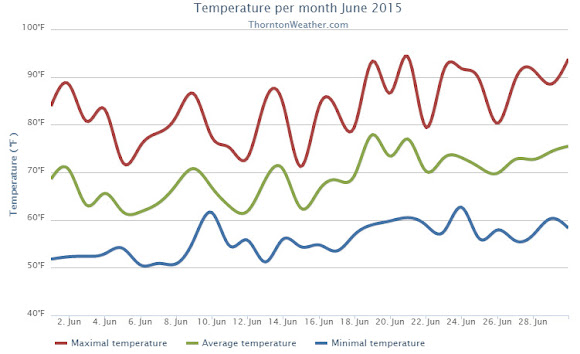
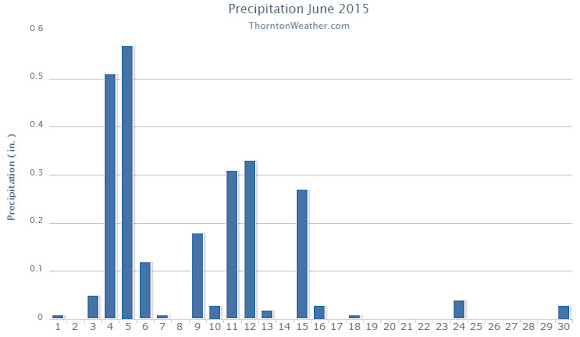
CLIMATE REPORT
NATIONAL WEATHER SERVICE BOULDER, CO
806 PM MDT SAT JUL 4 2015
...................................
...THE DENVER CO CLIMATE SUMMARY FOR THE MONTH OF JUNE 2015...
CLIMATE NORMAL PERIOD 1981 TO 2010
CLIMATE RECORD PERIOD 1872 TO 2015
WEATHER OBSERVED NORMAL DEPART LAST YEAR`S
VALUE DATE(S) VALUE FROM VALUE DATE(S)
NORMAL
................................................................
TEMPERATURE (F)
RECORD
HIGH 105 06/26/2012
06/25/2012
54/01/2206
LOW 30 06/02/1951
HIGHEST 94 06/30 94 06/26
LOWEST 51 06/03 42 06/15
AVG. MAXIMUM 82.9 82.4 0.5 83.4
AVG. MINIMUM 56.1 52.3 3.8 51.2
MEAN 69.5 67.4 2.1 67.3
DAYS MAX >= 90 6 7.9 -1.9 6
DAYS MAX <= 32 0 0.0 0.0 0
DAYS MIN <= 32 0 0.0 0.0 0
DAYS MIN <= 0 0 0.0 0.0 0
PRECIPITATION (INCHES)
RECORD
MAXIMUM 4.96 1882
MINIMUM T 1890
TOTALS 2.53 1.98 0.55 1.82
DAILY AVG. 0.08 0.07 0.01 0.06
DAYS >= .01 13 8.4 4.6 9
DAYS >= .10 5 4.6 0.4 5
DAYS >= .50 2 1.4 0.6 1
DAYS >= 1.00 0 0.3 -0.3 0
GREATEST
24 HR. TOTAL 0.99 06/05 TO 06/05 06/27 TO 06/27
SNOWFALL (INCHES)
RECORDS
TOTAL 0.0
TOTALS 0.0 0.0
DEGREE_DAYS
HEATING TOTAL 11 62 -51 30
SINCE 7/1 5583 6058 -475 6004
COOLING TOTAL 154 133 21 106
SINCE 1/1 158 155 3 127
FREEZE DATES
RECORD
EARLIEST 09/08/1962
LATEST 06/08/2007
EARLIEST 10/07
LATEST 05/05
........................................................
WIND (MPH)
AVERAGE WIND SPEED 9.0
RESULTANT WIND SPEED/DIRECTION 2/167
HIGHEST WIND SPEED/DIRECTION 36/160 DATE 06/24
HIGHEST GUST SPEED/DIRECTION 47/160 DATE 06/24
SKY COVER
POSSIBLE SUNSHINE (PERCENT) MM
AVERAGE SKY COVER 0.50
NUMBER OF DAYS FAIR 6
NUMBER OF DAYS PC 22
NUMBER OF DAYS CLOUDY 2
AVERAGE RH (PERCENT) 61
WEATHER CONDITIONS. NUMBER OF DAYS WITH
THUNDERSTORM 16 MIXED PRECIP 0
HEAVY RAIN 4 RAIN 5
LIGHT RAIN 16 FREEZING RAIN 0
LT FREEZING RAIN 0 HAIL 3
HEAVY SNOW 0 SNOW 0
LIGHT SNOW 0 SLEET 1
FOG 6 FOG W/VIS <= 1/4 MILE 1
HAZE 3
- INDICATES NEGATIVE NUMBERS.
R INDICATES RECORD WAS SET OR TIED.
MM INDICATES DATA IS MISSING.
T INDICATES TRACE AMOUNT.
